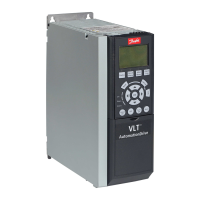FC 300 Design Guide
How to Program
" Parameters: Load and Motor
" 1-0* General Settings
Define whether the adjustable frequency
drive operates in speed mode or torque
mode; and whether the internal PID control
should be active or not.
1-00 Configuration Mode
Option:
*
Speed open-loop [0]
Speed closed-loop [1]
Torqu e [ 2]
Process [3]
Function:
Select the application control principle to be used
when a Remote Reference (via analog input) is
active. A Remote Reference can only be active when
par. 3-13 Reference Site is set to [0] or [1].
Speed open-loop [0]: Enables speed control
(without feedback signal from motor) with
automatic slip compensation for almost c onstant
speed at varying loads.
Compensations are active but can be disabled
in the Load/Motor par. group 1-0*.
Speed closed-loop [1]: Enables e ncode r feedback
from motor. Obtain full holding torque at 0 RPM.
For increased speed accuracy, provide a feedback
signal and set the sp eed PID control.
Torque [2]: Connects the encoder speed feedback
signal to the encoder input. Only possible
with “Flux with motor feedback” option, par.
1-01 Motor control principle.
Process [3]: Enables the use of process control in
the adjustable frequency drive. The process contro l
parameters are set in par. groups 7-2* and 7-3*.
This parameter cannot be adjusted while
the motor is running.
1-01 Motor Control Principle
Option:
U/f [0]
*
VVC
plus
[1]
Flux sensorless (FC 302 only) [2]
Flux w/ motor feedback(FC 302 only) [3]
Function:
Select which m otor control principle to emp loy.
Select U/f [0], a special motor mode, for parallel
connected motors in special motor applications.
When U/f is selected the characteristic of the control
principle can be edited in par. 1-55 and 1-5 6.
Select VVC
plus
[1] for a voltage vector control
principle suitable for most applications. The
main benefit of VVC
plus
operation is that it
uses a robust motor model.
Select Flux sensorless [2], i.e., flux vector control
without encoder feedback, for simple installation
and robustness against sudden load changes.
Select Flux with encoder feedback [3] for very
high accuracy speed and torque c ontrol, suitable
for the most demanding applications.
The best shaft performance is normally achieved
using either of the two flux vector control modes Flux
sensorless [2] and Flux with encoder feedb ack [3].
This parameter cannot be adjusted while
the motor is running.
1-02 Flux Motor Feedback Source
Option:
*
24 V encoder [1]
MCB 102 [2]
MCO 305 [3]
Function:
Select the interface at which to receive feedback
from motor or process.
24V encoder [1] is an A and B channel encoder,
which ca n be connected to the d igital input
terminals 32/33 only. Terminals 32/33 must
be programmed to no function.
MCB 102 [2] is an encoder module option
which can be configured in par. group 17-**
Parameters - Encoder Input.
MCO 305 [3]isanoptionforpositioning,
synchronizing and programming.
This parameter cannot be adjusted while
the motor is running.
This parameter appears in FC 302 only.
1-03 Torque Characteristics
Option:
*
Constant torque [0]
Variable torque [1]
Auto Energy Optim. [2]
*
default setting ()display text []value for use in communication via serial communication port
159
MG.33.B
6.22 - V LT is a registered Danfoss trademark
